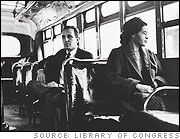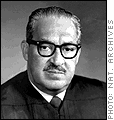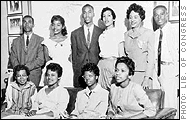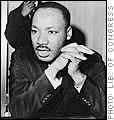Heroes of the Civil Rights Movement

Learn about the heroes of the American civil rights movement, including Rosa Parks, Martin Luther King, Jr., Thurgood Marshall, and more.
by Borgna Brunner
 Rosa Parks, seated on a Montgomery bus. Related Links |
The civil rights movement of the 1950s and 1960s challenged racism in America and made the country a more just and humane society for all. Below are a few of its many heroes.
Rosa Parks
On December 1, 1955, in Montgomery, Alabama, Rosa Parks, an African-American seamstress, left work and boarded a bus for home. As the bus became crowded, the bus driver ordered Parks to give up her seat to a white passenger. Montgomery's buses were segregated, with the seats in the front reserved for "whites only." Black people had to sit at the back of the bus. But if the bus was crowded and all the "whites only" seats were filled, Black people were expected to give up their seats—a Black person sitting while a white person stood would never be tolerated in the racist South. Rosa had had enough of such humiliation, and refused to give up her seat. "I felt I had a right to stay where I was," she said. "I wanted this particular driver to know that we were being treated unfairly as individuals and as a people." The bus driver had her arrested.
Martin Luther King, Jr., heard about Parks's brave defiance and launched a boycott of Montgomery buses. The 17,000 Black residents of Montgomery pulled together and kept the boycott going for more than a year. Finally, the Supreme Court intervened and declared segregation on buses unconstitutional. Rosa Parks and the boycotters defeated the racist system, and she became known as "the mother of the civil rights movement."
Rosa Parks: A Video
Martin Luther King, Jr.
It wasn't just that Martin Luther King became the leader of the civil rights movement that made him so extraordinary—it was the way in which he led the movement. King advocated civil disobedience, the non-violent resistance against unjust laws: "Non-violence is a powerful and just weapon which cuts without wounding and ennobles the man who wields it." Civil rights activists organized demonstrations, marches, boycotts, strikes, and voter-registration drives, and refused to obey laws that they knew were wrong and unjust.
These peaceful forms of protest were often met with vicious threats, arrests, beatings, and worse. King emphasized how important it was that the civil rights movement did not sink to the level of the racists and hate mongers they fought against: "Let us not seek to satisfy our thirst for freedom by drinking from the cup of bitterness and hatred," he urged. "We must forever conduct our struggle on the high plane of dignity and discipline." King's philosophy of "tough-mindedness and tenderheartedness" was not only highly effective, but it gave the civil rights movement an inspiring moral authority and grace.
Martin Luther King, Jr.: A Video

Thurgood Marshall
Read about Plessy v. Feguson, the Supreme Court's "separate but equal" doctrine that was overturned by Brown v. Board of Education of Topeka.
Thurgood Marshall
Thurgood Marshall was a courageous civil rights lawyer during a period when racial segregation was the law of the land. At a time when a large portion of American society refused to extend equality to Black people, Marshall astutely realized that one of the best ways to bring about change was through the legal system. Between 1938 and 1961, he presented more than 30 civil rights cases before the Supreme Court. He won 29 of them.
His most important case was Brown v. Board of Education of Topeka (1954), which ended segregation in public schools. By law, Black and white students had to attend separate public schools. As long as schools were "separate but equal"—providing equal education for all races—segregation was considered fair. In reality, segregated schools were shamefully unequal: white schools were far more privileged than Black schools, which were largely poor and overcrowded. Marshall challenged the doctrine, pointing out that "separate but equal" was just a myth disguising racism. He argued that if all students were indeed equal, then why was it necessary to separate them? The Supreme Court agreed, ruling that "separate educational facilities are inherently unequal." Marshall went on to become the first African-American Supreme Court Justice in American history.
Thurgood Marshall: A Video

The Little Rock Nine pictured with Daisy Bates, the president of the Arkansas NAACP.
The Little Rock Nine
The Little Rock Nine, as they later came to be called, were the first Black teenagers to attend all-white Central High School in Little Rock, Arkansas, in 1957. These remarkable young African-American students challenged segregation in the deep South and won.
Although Brown v. Board of Education outlawed segregation in schools, many school systems defied the law by intimidating and threatening Black students—Central High School was a notorious example. But the Little Rock Nine were determined to attend the school and receive the same education offered to white students. Things grew ugly and frightening right away. On the first day of school, the governor of Arkansas ordered the state's National Guard to block the Black students from entering the school. Imagine what it must have been like to be a student confronted by armed soldiers! President Eisenhower had to send in federal troops to protect the students.
But that was only the beginning of their ordeal. Every morning on their way to school angry crowds of whites taunted and insulted the Little Rock Nine—they even received death threats. One of the students, fifteen-year-old Elizabeth Eckford, said "I tried to see a friendly face somewhere in the mob. . . . I looked into the face of an old woman, and it seemed a kind face, but when I looked at her again, she spat at me." As scared as they were, the students wouldn't give up, and several went on to graduate from Central High. Nine Black teenagers challenged a racist system and defeated it.
The Little Rock Nine: A Video
About the author









